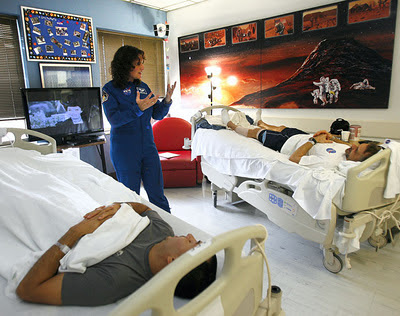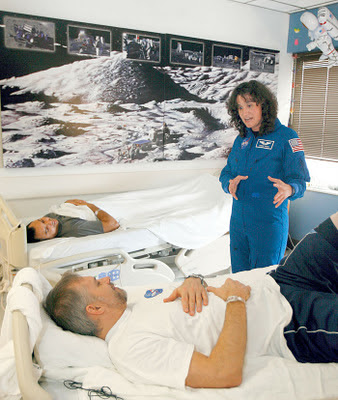Dr. Serena M. Auñón (35) of League City, TX was one of the two flight doctors chosen in the last astronaut selection. The Galveston Daily News reported on her visit to the NASA ward at the University of Texas Medical Branch, where she visited with study subjects in the current flight simulation programs.
Participants David Sarmiento and William Widener were in the long-term bed-rest study in the Flight Analog Research Unit at the time, in the now-famed Head-Down Tilt. In this position, participants show physiologic changes similar to those expressed by astronauts in microgravity. Changes in blood pressure and blood plasma volume result when the heart works about 15-20% less, and of course the creation of bone mineral density in the body also changes.

Sarmiento, 35, a commercial diver from Maryland &
Widener, 42, a fitness instructor from North Carolina
Widener, 42, a fitness instructor from North Carolina
Like many subjects before them, the newest recruits attest to a new appreciation of how astronauts cope with weightlessness on their missions, as they find the studies are both physically and mentally demanding. Said one new participant: "I have a greater understanding of the physical effects of zero gravity. It's not just floating. It affects your whole body."
Astronaut Auñón, who completed residencies in both internal medicine and aerospace medicine at UTMB, so she knows a little something about the value of the NASA studies:
"We learn a tremendous amount from astronauts and their experiences aboard the Space Station. Those numbers are small and a larger body of evidence is needed. Head-down bed rest is one of our best analogues. The women and men who volunteer to take part as subjects in the bed rest facility provide invaluable data regarding physiological changes in a 'weightless' environment."
It's also an amazing way to do your part for space exploration, and everything scientists learn about human bodies in these studies gets us closer to planet Mars. Still, it must have been nice to get some personal recognition from an astronaut! They of all people know how much sacrifice can be involved in the stringent protocols. Testing yourself in the way astronauts train? Not for sissies!

Other articles in the past few months regarding the studies have been very positive! We are truly seeing gratifying results in term of how space studies further our knowledge of how to live in micro-gravity, but also the practical benefits that can be applied to life on Earth:
July 13, 2011: Sentara Offers NASA-Developed Treadmill For Therapy
Space study treadmill used for orthopedic patients, senior rehabilitation conditioning, military members endurance and strengthening, etc.
November 29, 2011: Bed Rest Study Provides Invaluable Data for NASA
Information on exercise, muscles, bones and hearts to keep astronauts healthier.
December 21, 2011: From Here To Maternity
Months in bed to stop miscarriage? Practical considerations to involuntary bedrest.
January 2012: Rehab: Space Technology Helping to Heal & Strengthen
Space mission technology adapted and approved by the FDA for use in injury rehabilitation, Neuro-Muscular control, pre- and post- joint replacement surgery conditioning and athletic training.
These have also all been added to the archive of Articles on Pillownaut.com.


































































